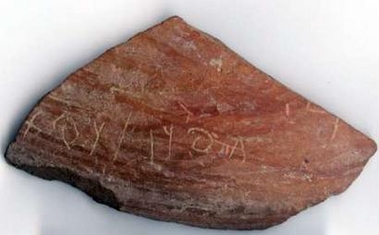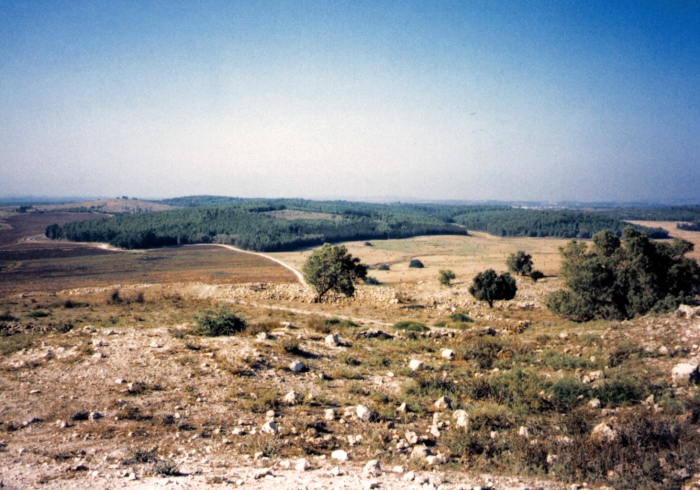"This
is a groundbreaking find," he said of the rust-coloured ceramic
found at Tel es-Safi. "Here we have very nice evidence the name
Goliath appearing in the Bible in the context of the story of David
and Goliath ... is not some later literary creation." (Maeir,
Head of the archaeology department at Bar-Ilan University near Tel
Aviv, November, 2005) [Artifact shown later].
Of course,
with almost any evidence dug up, there are skeptics who would
downplay and trivialize what was found. Long before there was
physical evidence to consider, there were (and still are) many who
minimized the actual Biblical accounts. At best they hold the
accounts to be an amalgam of ancient legends, or perhaps contrived
stories designed to bolster and foster later national unity. For
example, believing that a number of stories were merged together,
some claim that the Bible has mixed up who killed Goliath, citing
additional passages in 1 Chronicles and 2 Samuel (parallels to each
other) as their proof.
1
Chronicles 20:5-8a In another battle with the Philistines, Elhanan
son of Jair killed Lahmi the brother of Goliath the Gittite, who had
a spear with a shaft like a weaver's rod. 6 In still another battle,
which took place at Gath, there was a huge man with six fingers on
each hand and six toes on each foot - twenty-four in all. He also was
descended from Rapha. 7 When he taunted Israel, Jonathan son of
Shimea, David's brother, killed him. 8 These were descendants of
Rapha in Gath, and they fell at the hands of David and his men. (NIV)
2 Samuel
21:15-22 Once again there was a battle between the Philistines and
Israel. David went down with his men to fight against the
Philistines, and he became exhausted. 16 And Ishbi-Benob, one of the
descendants of Rapha, whose bronze spearhead weighed three hundred
shekels and who was armed with a new [sword], said he would kill
David. 17 But Abishai son of Zeruiah came to David's rescue; he
struck the Philistine down and killed him. Then David's men swore to
him, saying, "Never again will you go out with us to battle, so
that the lamp of Israel will not be extinguished." 18 In the
course of time, there was another battle with the Philistines, at
Gob. At that time Sibbecai the Hushathite killed Saph, one of the
descendants of Rapha. 19 In another battle with the Philistines at
Gob, Elhanan son of Jaare-Oregim the Bethlehemite killed Goliath the
Gittite, who had a spear with a shaft like a weaver's rod. 20 In
still another battle, which took place at Gath, there was a huge man
with six fingers on each hand and six toes on each foot - twenty-four
in all. He also was descended from Rapha. 21 When he taunted Israel,
Jonathan son of Shimeah, David's brother, killed him. 22 These four
were descendants of Rapha in Gath, and they fell at the hands of
David and his men. (NIV)
The
timeframe of these passages are in the years which followed David
ascension to the throne, many years after his exploits with Goliath
as a young man (read from the first of 1 Chronicles). There is no
possibility that these two later passages are to be confused with
David's original heroic act. Verse eight of 1 Chronicles and verse
twenty-two of 2 Samuel even establishes what these later passages are
professing to do. They were showing that the four remaining
descendants of the Philistine Rapha from Gath were subsequently
defeated in David's name, though not necessarily physically by David
(as the original Goliath had been). More on where David's original
battle took place is here. For the record,
the Philistines and who killed them...
|
Big
Philistines Killed |
Killed by |
|
#1.
Goliath from Gath
(1 Samuel
17:4-7, 48-51 ... Nine feet tall. Spear like weaver's rod. 600 shekel
spear head) |
David (as
a young man) |
|
#2. Lahmi
brother of Goliath the Gittite
(1
Chronicles 20:1 ... Spear like weaver's rod)
Goliath
the Gittite
(2 Samuel
21:19 ... Spear like a weaver's rod) |
Elhanan
son of Jair
Elhanan
son of Jaare-Oregim
(Jair
"the Weaver") |
|
#3.
"Huge man"
(1
Chronicles 20:6, 2 Samuel 21:20 ... six fingers and six toes) |
Jonathan
son of Shimea,
brother of David |
|
#4. Ishbi-Benob
(2 Samuel
21:16-17 ... 300 shekel spear head) |
Abishai
son of Zeruiah |
|
#5. Saph
(2 Samuel 21:18) |
Sibbecai
the Hushathite |
Numbers
2-5 were all killed far after the event with David and Goliath.
Number 2 is one that is cited as a contradiction, as 2 Samuel (in
many translations) calls him Goliath, rather than Lahmi brother of
Goliath. Translations such as King James have added in the obviously
missing "brother of". It is apparent that 2 Samuel 21:19 is
one of the rare scribal errors brought to us from antiquity, but God
had the account recorded twice in Scriptures so that we could still
clearly see what was intended! How can we be sure that it is a
scribal error introduced through copying? Consider the name of the
one who killed him. Jair becomes Jaare-Oregim in the passage in
question. The Jaare and Jair are variations of the same name (common
in many ancient names). The addition of an extra word in association
with his name points to what happened during the scribal
transcription. Oregim means "weaver" - a word copied from
the next line in the Hebrew text, a word that was associated with the
spear of the deceased. Having dropped a word, "brother of"
and added a word "weaver" the word count for the line would
still work, thus making it harder for the error to be caught. Even if
he had been a fifth person called Goliath (that would numerically
contradict 2 Samuel 21:22) - highly unlikely but not impossible that
descendants of the same individual could have identical names - this
Goliath, by the established timeframe, could not be the same one
killed years earlier by David. As for similarities between
instruments carried and physical characteristics of these descendents
of Rapha, it is highly credible, even assumed, that they would have
many, all being close relatives in a common army.
The
descendants of Rapha, though part of the Philistine army, were not
truly Philistines - in other words, descendants of the sea peoples
that settled in this coastal area. Rather they were remnants of the
native Anakites who had lived in the land before Israel returned from
Egypt. The Philistine people seemed to have been quite willing to
accept them into their alliance, especially in support of their
military ambitions. The Anakites were well known as being a tall race
of strong warriors. They were under God's judgment and were to have
been destroyed by Israel, yet after the conquests of Joshua pockets
still remained.
Deuteronmy
9:2-3 The people are strong and tall - Anakites! You know about them
and have heard it said: "Who can stand up against the Anakites
?" 3 But be assured today that the Lord your God is the one who
goes across ahead of you like a devouring fire. He will destroy them;
he will subdue them before you. And you will drive them out and
annihilate them quickly, as the Lord has promised you. (NIV)
Joshua
11:22 No Anakites were left in Israelite territory; only in Gaza,
Gath and Ashdod did any survive. (NIV)
Notice
that one of the final locations where the Anakites were still found
in Israeli territory was Gath, home of Goliath (1 Samuel 17:4).
Physical
evidence from archaeology, as to the personal existence of Goliath,
is understandably scarce. Goliath as one of the Anakites, and a
descendant of Rapha, though formidable, was merely one of a number of
impressive warriors from his era. His demise at the hands of an
unknown, David, in such an ignoble way guaranteed that his own people
would not memorialize him. Victors, in this case Israel, are the ones
who normally commemorate the battles won.
While the
discovery is not definitive evidence of Goliath's existence, it does
support the Bible's depiction of life at the time the battle was
supposed to have occurred, said Dr. Aren Maeir, a professor at
Bar-Ilan University and director of the excavation.
"What
this means is that at the time there were people there named
Goliath," he said. "It shows us that David and Goliath's
story reflects the cultural reality of the time." In the story,
David slew Goliath with a slingshot.
Some
scholars assert the story of David slaying the giant Goliath is a
myth written down hundreds of years later. Maeir said finding the
scraps lends historical credence to the biblical story.
The shard
dates back to around 950 BC, within 70 years of when biblical
chronology asserts David squared off against Goliath, making it the
oldest Philistine inscription ever found, the archaeologists said.
(Canadian Press, November 10, 2005)
The
evidence that Goliath was not a story invented many years later - as
some Bible skeptics have long claimed - comes from an inscribed
fragment of pottery. The name on it appears to be none other than
Goliath. In fact there is no way to know that it is the Goliath of
Scriptures, but it comes from the right geographic location and from
the right timeframe of archaeology! What it does make clear is that
Philistines in that area and era used the name Goliath. This
testifies to the Bible recording faithful a name from this ancient
time. Biblical details are always significant and accurate.

A
shard of pottery unearthed in a decade-old dig in southern Israel
carries an early Semitic inscription, a Philistine rendering of the
name of the biblical giant, Goliath, is seen in this handout picture
released by Bar Ilan University November 8, 2005. |
